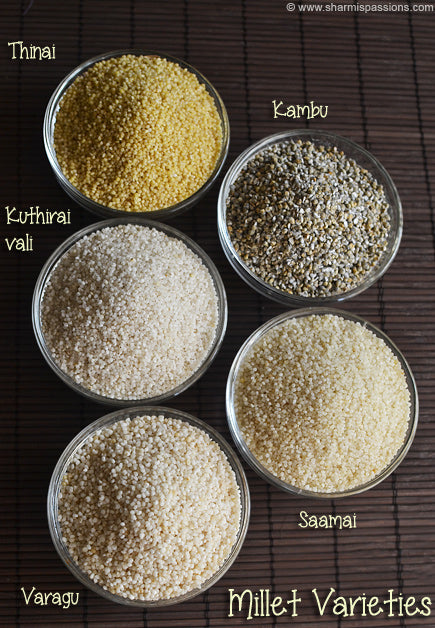

Millet Cooking Guide: Exploring Various Types of Millets and How to Cook Them
As the demand for wholesome and nutritious food continues to rise, millets have garnered significant attention for their exceptional health benefits and culinary versatility. In this comprehensive guide, we will delve into the world of millets, exploring their diverse types and providing insights into how to cook them to maximize their health benefits.
Introduction to Millets
Definition and Popularity
Millet, a group of small-seeded grains, has gained popularity as a healthful food choice due to its exceptional nutritional content and gluten-free nature. This ancient grain has been a staple in many cultures for centuries and is revered for its diverse health benefits.
Global Cultivation
Millet is cultivated extensively across the globe, with significant production in countries like India and Nigeria. Its growth in popularity is attributed to its adaptability to various climates and its exceptional nutritional profile.
Nutritional Value and Endorsements
Endorsed by nutritionists for its rich nutritional content, millet offers a range of essential nutrients, including carbohydrates, protein, and vital minerals. Its low glycemic index and high fiber content make it a preferred choice for individuals seeking nutritious alternatives to traditional grains like brown rice and quinoa.
Types of Millets
Foxtail Millet (Kakum/Kangni)
Foxtail millet, known as Kakum or Kangni, is a popular millet variety known for its high protein content and versatility in culinary applications.
Proso Millet (Chena/Barri)
Proso millet, also referred to as Chena or Barri, is valued for its nutritional density and is used in various dishes due to its mild flavor and adaptability.
Sorghum Millet (Jowar)
Sorghum millet, commonly known as Jowar, is celebrated for its versatility in cooking and its potential health benefits, making it a valuable addition to a balanced diet.
Finger Millet (Ragi)
Finger millet, also known as Ragi, is renowned for its high calcium content and is often used in the preparation of nutritious porridges and baked goods.
Pearl Millet (Bajra)
Pearl millet, also called Bajra, is recognized for its energy-boosting properties and is employed in various culinary creations due to its robust flavor.
Brown Top Millet (Korle)
Brown top millet, known as Korle, is appreciated for its nutritional benefits and is utilized in diverse meal preparations for its unique texture and flavor.
Barnyard Millet (Sanwa)
Barnyard millet, commonly referred to as Sanwa, is celebrated for its fast-growing nature and culinary diversity, adding a nutritious touch to various dishes.
Little Millet (Moraiyo)
Little millet, also known as Moraiyo, is a nutritional powerhouse, offering a rich source of essential nutrients and culinary adaptability.
Kodo Millet (Kodra/Varagu)
Kodo millet, recognized as Kodra or Varagu, is an ancient grain celebrated for its health benefits and diverse culinary applications.
Buckwheat Millet (Kuttu)
Buckwheat millet, also referred to as Kuttu, is a gluten-free grain known for its rich nutritional content and is utilized in nutritious recipes.
Cooking with Millets
How to Cook Foxtail Millet
Foxtail millet can be prepared by combining one part millet with two and a half parts water in a saucepan. Bring the water to a boil, then reduce the heat, cover, and let the millet simmer for approximately 25 minutes or until the grains are tender and the water is absorbed. Culinary uses include porridges, pilafs, and baked goods.
Preparing Proso Millet
Proso millet can be cooked using similar instructions to foxtail millet, offering a versatile grain for a wide variety of culinary applications. Its mild flavor makes it suitable for both sweet and savory dishes, ranging from breakfast porridges to pilafs and salads.
Cooking Methods for Sorghum Millet
Sorghum millet can be cooked using various methods such as boiling, steaming, or pressure cooking. Its versatility allows for its incorporation into dishes such as soups, stews, and gluten-free baked goods.
Recipes for Finger Millet
Finger millet can be utilized in the preparation of nutritious porridges, baked goods, and savory dishes, offering a rich source of calcium and essential nutrients.
Pearl Millet Cooking Tips
Pearl millet's robust flavor and energy-boosting properties make it suitable for the preparation of hearty porridges, bread, and traditional dishes in various culinary traditions.
Using Brown Top Millet in the Kitchen
Brown top millet's nutritional benefits and unique texture make it an ideal ingredient for pilafs, salads, and side dishes, contributing to its diverse culinary applications.
Barnyard Millet Recipes
Barnyard millet's fast-growing nature and culinary adaptability make it suitable for a variety of dishes, including risottos, pilafs, and desserts.
Meal Ideas for Little Millet
Little millet's rich nutritional profile makes it an ideal addition to breakfast porridges, salads, and as a rice substitute in various culinary creations.
Incorporating Kodo Millet into Meals
Kodo millet's health benefits and ancient heritage make it a valuable addition to soups, stews, and side dishes, offering a rich source of essential nutrients.
Buckwheat Millet Cooking Guide
Buckwheat millet's gluten-free nature and rich nutritional content make it suitable for a wide range of recipes, including pancakes, porridges, and baked goods.
Nutritional Value of Different Millets
Calories, Carbohydrates, and Protein Content
Millets offer varying caloric, carbohydrate, and protein content, with each type providing unique nutritional benefits suitable for diverse dietary needs.
Comparison of Nutritional Contents
When compared per 100 grams, different millets showcase variations in nutritional content, offering individuals a wide range of choices to meet their specific nutritional requirements.
Health Benefits of Millets when Cooked
Enhancing Digestive Health
Millet-based dishes promote regular bowel movements and support a healthy digestive system due to their high fiber content.
Gluten Intolerance and Millet as a Gluten-Free Option
Millet serves as an excellent alternative to gluten-containing grains, making it suitable for individuals with gluten intolerance or celiac disease.
Promoting Heart Health with Millet Recipes
The nutritional properties of millets contribute to heart health, supporting overall cardiovascular well-being.
Mood Enhancement Properties of Millets
Millet contains essential nutrients that contribute to mood regulation, potentially enhancing mental well-being.
Millets in Weight Management
The satiating properties of millets make them suitable for individuals looking to manage their weight, potentially reducing overall calorie intake.
Potential Side Effects
Risks of Thyroid Issues
Excessive consumption of millets may pose risks related to thyroid function, particularly for individuals with existing thyroid conditions.
Possibility of Digestive Distress
Improper preparation of millets may lead to digestive distress, emphasizing the importance of cooking and preparing millets appropriately.
Weighing Concerns about Managing Weight
While millets can aid in weight management, individuals should consider the overall balance of their diet and calorie intake when incorporating millets into their meals.
Allergy Potentials
As with any food, some individuals may experience allergic reactions to millets, necessitating awareness and caution.
Considerations for Individuals with Kidney Concerns
Individuals with kidney concerns should exercise caution when consuming millets, considering the oxalate content that may contribute to kidney stone formation.
FAQs on Cooking Millets
Identifying the Millet with the Highest Fiber
For individuals seeking a high-fiber option, finger millet stands out as a valuable choice due to its exceptional fiber content.
Choosing the Right Millet as a Substitute for Rice
Barnyard millet, with its similar texture and versatility, serves as an ideal substitute for rice in various dishes.
Best Millets for People with Diabetes
Proso millet and Kodo millet are considered suitable choices for individuals with diabetes due to their low glycemic index and potential health benefits.
In conclusion, the diverse types of millets offer a rich tapestry of culinary and nutritional possibilities, providing individuals with an array of options to enhance their well-being and dietary experiences. By understanding the unique characteristics of each type of millet and exploring their diverse culinary applications, individuals can maximize the health benefits and sensory appeal of these ancient grains. Whether incorporated into savory pilafs, energy-boosting porridges, or gluten-free baked goods, millets stand as a testament to the enduring legacy of wholesome and nourishing foods. Embracing the culinary diversity of millets encourages individuals to embark on a journey of flavor exploration and nutritional enrichment, celebrating the rich tradition and modern adaptability of these exceptional grains.
